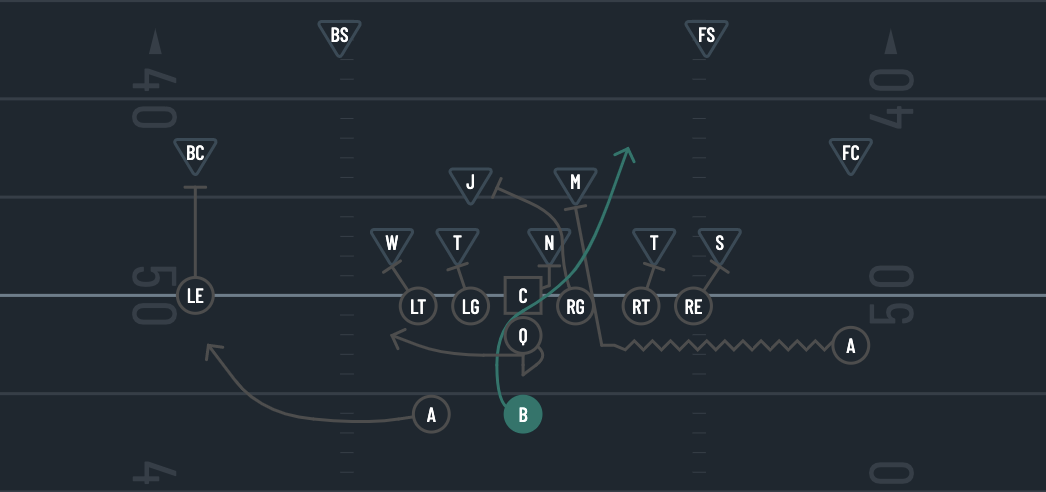Armed Forces Bowl 2022: Air Force Runs Unique Version of "Fullback ISO"
An example of how watching the O-line tells you more than watching the ball/backfield
Air Force runs a very unique flavor of the flexbone option offense. They run a lot of double options and called runs from a wide range of formations, backfield actions, and motions.
Something I thought was worth posting about is how they ran a “fullback ISO” play off what appears to the untrained eye to look like fullback trap. To the untrained eye, some plays appear the same, but in reality are quite different (and announcers often don't see it either and feed us misinformation on their analysis).
Fullback Trap
On Air Force's opening drive, they ran a couple fullback traps. In most systems that deploy a "fullback trap," the fullback starts off to the back-side of the play, then bends back to the play-side.

On a trap play, you have the O-line blocking to the back-side with a back-side guard pulling and “trapping” an unblocked defensive lineman. On this play, it’s a FB trap right. The O-line blocks to their left (back-side) an the left guard pulls and traps to the right. The “action” of the backfield is designed to look like veer or "triple option” going to the opposite side, with the fullback then bending back to the trap side.
Air Force’s Fullback ISO
Later in that opening drive, Air Force ran what appeared to be in the backfield fullback trap, but instead it was something very different in terms of blocking scheme. It was “FB ISO,” but in a way I’ve never seen it ran before.

The play is at the 11:25 mark (AF's opening drive).
As you can see, the backfield action between the trap and ISO are almost identical, but the blocking is very different. We also see ISO plays being ran more from a standard I-formation, or to the fullback from the belly/down series of the Wing-T offense. Again, I thought this was cool, because it’s a way of running ISO I have never seen or heard of before.
The “ISO” stands for “isolation,” meaning the offense is leaving a linebacker alone, isolating them, for a lead blocker to come through and block (the A-back who went in motion). Back-side of the point of attack, the O-line blocks back-side. Play-side of the point of attack, the O-line blocks play-side.
The fullback runs the “fullback trap” path, but instead of sliding off a wall of down or back-side blocks and inside of the kick-out block, they are cutting back and following the A-back through the hole.
Air Force loves to play around with their O-line splits too, so as you can see, the right guard and right tackle take wider than normal splits, which opens up the point of attack more.
Something I found cool (though it’s more of a technicality)…Air Force starts this play off in a formation we rarely ever see anymore: An old-school 21 personnel (2-RB, 1-TE) Near/Far back set, like what a lot of teams ran between the 1950's through 1990's. Air Force is in a 31 personnel set, but I still thought it was a cool “shoutout” of sorts.
For reference, here is an image of what many think of when we hear about an ISO play (ran from an I-formation).
Play Calling: ISO vs. Trap
While the formations for Air Force were different, they were up against an under front from Baylor against both the trap and ISO play. “Under Front:” Nose guard (NG) in strong-side A-gap (center-guard gap), and a D-lineman in the strong-side C-gap (tackle-TE gap), and another D-lineman to the weak-side in the B-gap (guard-tackle gap).
Fullback trap is typically not a great look running into an under front (to the nose guard side). Air Force ran it well, but again, it’s a tough bounce or bend for the fullback, because that nose guard can force the cut-back to bounce wider than desired.
I think the reason Air Force called this ISO play was to get a better double team on the nose guard. On the fullback trap, the center has to block back on the weak-side D-lineman in the B-gap leaving the right guard alone to block the NG. They block back so the left guard can pull. by running ISO, the left guard now stays home and can block that weak-side D-lineman, freeing up the center to double team the NG with the right guard. On the play Air Force ran, the center and right guard get a good double team on the NG, and the right guard then climbs up to the back-side linebacker.
Watch the Lines!
This use of FB ISO is just another way to show that as fans of the game, we have to pay attention to the offensive and defensive lines more than the backfield action, QB, or the ball. By watching the lines, we can learn so much more of what is happening and see the flow/development of both teams’ offense and defense throughout a game, and find changes or adjustments in play calling easier.
Summary
Air Force is a fun offense to watch, because of all the various formations, motions, and twists on different run plays they use. Definitely start following and watching them if you like interesting or unique offenses. They are “flexbone option” at their core, but not a traditional “triple option” team like most announcers and media portray them as.
Air Force ran a version of ISO I’ve never seen before, as a way to compliment their fullback trap (If you’ve seen this variation before, please reach out to me and tell me more).
As a fan of the game, it’s important to keep your eye on the lines, not the backfield, ball, or QB.




